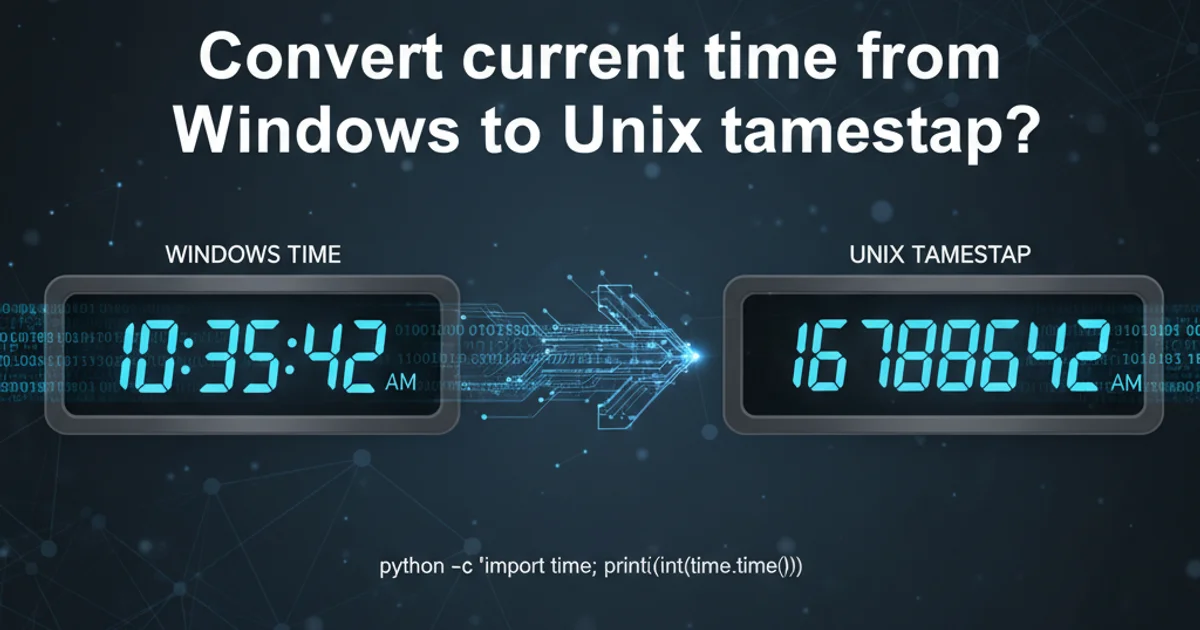Convert current time from Windows to Unix timestamp?
Categories:
Converting Windows Time to Unix Timestamp in C/C++

Learn how to accurately convert current system time from Windows' native time format to a Unix timestamp using C/C++ APIs, addressing common pitfalls and ensuring cross-platform compatibility.
Working with time in C/C++ applications often involves converting between different time representations. While Unix-like systems predominantly use Unix timestamps (seconds since January 1, 1970, UTC), Windows systems internally use FILETIME structures, which represent time as the number of 100-nanosecond intervals since January 1, 1601, UTC. This article provides a comprehensive guide on how to convert the current Windows system time into a Unix timestamp, focusing on accuracy and best practices.
Understanding Time Formats: FILETIME vs. Unix Timestamp
Before diving into the conversion, it's crucial to understand the two primary time formats we're dealing with:
FILETIME(Windows): This structure represents a 64-bit value representing the number of 100-nanosecond intervals since 12:00 A.M. January 1, 1601, UTC. It's used by many Windows API functions, includingGetSystemTimeAsFileTime.Unix Timestamp (Epoch Time): This is a 32-bit or 64-bit integer representing the number of seconds that have elapsed since 00:00:00 Coordinated Universal Time (UTC), Thursday, 1 January 1970, minus leap seconds. It's a widely used standard in computing for storing and comparing points in time.
flowchart TD
A[Get Current System Time (Windows)] --> B{FILETIME Structure}
B --> C["Convert FILETIME to 64-bit integer (100ns intervals)"]
C --> D["Adjust for Epoch Difference (1601 vs 1970)"]
D --> E["Convert 100ns intervals to seconds"]
E --> F[Unix Timestamp (seconds since 1970)]Flowchart of Windows FILETIME to Unix Timestamp Conversion Process
The Conversion Logic
The core of the conversion involves a few key steps:
- Obtain Current Time: Use
GetSystemTimeAsFileTimeto get the current UTC time as aFILETIMEstructure. - Combine High and Low Parts: The
FILETIMEstructure consists of twoDWORDmembers (dwLowDateTimeanddwHighDateTime). These need to be combined into a single 64-bit integer (ULARGE_INTEGERorlong long) to represent the total 100-nanosecond intervals. - Account for Epoch Difference: The
FILETIMEepoch is January 1, 1601, while the Unix epoch is January 1, 1970. The difference between these two epochs needs to be subtracted from theFILETIMEvalue. This difference is a constant number of 100-nanosecond intervals. - Convert to Seconds: Finally, divide the adjusted 100-nanosecond interval count by 10,000,000 (since 1 second = 10,000,000 * 100-nanosecond intervals) to get the Unix timestamp in seconds.
116444736000000000LL 100-nanosecond intervals. This value accounts for the 369 years and leap days between the two epochs.#include <windows.h>
#include <iostream>
// Constant for the difference between 1601-01-01 and 1970-01-01 in 100-nanosecond intervals
// (369 years * 365 days/year + 89 leap days) * 24 hours/day * 60 minutes/hour * 60 seconds/minute * 10,000,000 (100ns/sec)
#define WINDOWS_TICK 10000000LL
#define SEC_TO_UNIX_EPOCH 11644473600LL
long long GetUnixTimestampFromWindowsTime()
{
FILETIME ft;
GetSystemTimeAsFileTime(&ft);
ULARGE_INTEGER uli;
uli.LowPart = ft.dwLowDateTime;
uli.HighPart = ft.dwHighDateTime;
// Convert 100-nanosecond intervals to seconds
// Subtract the difference between Windows epoch (1601-01-01) and Unix epoch (1970-01-01)
return (uli.QuadPart / WINDOWS_TICK) - SEC_TO_UNIX_EPOCH;
}
int main()
{
long long unixTimestamp = GetUnixTimestampFromWindowsTime();
std::cout << "Current Unix Timestamp: " << unixTimestamp << std::endl;
return 0;
}
C++ code to convert current Windows system time to Unix timestamp.
Considerations for Time Zones and Precision
The GetSystemTimeAsFileTime function returns the current Coordinated Universal Time (UTC). This is crucial because Unix timestamps are also defined in UTC. Therefore, the conversion directly yields a UTC Unix timestamp, which is generally the desired behavior for consistency and portability.
If you need a local time Unix timestamp, you would first convert the FILETIME to a local time structure (e.g., using FileTimeToLocalFileTime and then FileTimeToSystemTime or FileTimeToDosDateTime), and then convert that local time to a Unix timestamp, but this is generally discouraged for storage and network communication due to time zone complexities. Always prefer UTC for internal time representations.
Regarding precision, FILETIME offers 100-nanosecond resolution. While the Unix timestamp typically represents seconds, you can retain higher precision by keeping the ULARGE_INTEGER value and dividing by a smaller factor if your application requires sub-second timestamps (e.g., milliseconds or microseconds since epoch).
long long (64-bit) is standard for timestamps now, older systems or specific compiler settings might default to 32-bit time_t, which can overflow in 2038 (the 'Year 2038 problem'). Always use long long for Unix timestamps to avoid this.